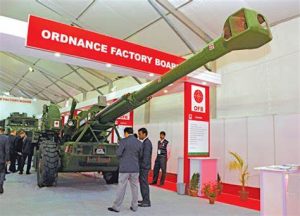 By Dr S N Mishra in Bhubaneswar, October 16, 2021: There is a flutter in the defence sector that 41 ordnance factories, with an antiquity as old as 1787 will be corporatized in to seven companies wef 1st October. Corporatisation was listed as one of the 167 transformational ideas to be implemented in the first 100 days of NDA manifesto (2019).
By Dr S N Mishra in Bhubaneswar, October 16, 2021: There is a flutter in the defence sector that 41 ordnance factories, with an antiquity as old as 1787 will be corporatized in to seven companies wef 1st October. Corporatisation was listed as one of the 167 transformational ideas to be implemented in the first 100 days of NDA manifesto (2019).
Beginning with Gunpowder factory at Ishapore in 1787, Gun & Shell Factory at Cossipore in 1801, they were the pioneers in establishing the first modern steel plant before the Tatas came in, the first electric textile mill and first Chemical factory in the verdant hills of Arvakandu, the Ordnance factories produce a bewildering range of products, from critical deliverables like small arms, ammunition, explosives, artillery, armoured vehicles to low tech items like uniform, shoes and parachutes.
With around $3 billion turnover per year, they have a credible record in supporting the three arms of the services in the two wars with Pakistan and spat in Karghil in 1999. Despite these solid achievements, they have been hemmed around with the criticism of inefficiency, poor quality, high cost and poor governance and accountability from time to time.
While the TKA Nair Committee (2000) had suggested converting Ordnance Factory Board created in 1979 to OF Corporation Ltd, Vijay Kelkar had recommended in 2006 that the new Corporation should be given Nava Ratna status like the HAL, which will help them to enter in to JV arrangement with Original Equipment Manufacturers, Co develop products with reputed design houses . Admiral Raman Puri in 2014 had recommended splitting Ordnance factories in to three clusters viz, weapons, ammunition & Combat vehicles.
The present arrangement of the government is significantly different since four proposed PSUs will continue to handle gliders, parachutes, optics, components and ancillaries, and products designed for troop comfort. This will perpetuate poor quality, delay and high price in products which can be easily be sourced from private players at better price& quality. While it made sense during the world wars when private sector capability was inadequate, India after 1991 with its thrust on Liberalization, Privatization & Globalization (LPG) must not perpetuate making this low tech, non-strategic items in captive ordnance factories.
 The 1956 Industrial Policy Resolution made defence manufacturing sector the exclusive prerogative of Defence PSUs & Ordnance Factories. Given their strategic nature the government was late in embracing economic liberalization by a decade. In 2001 it allowed private sector to participate 100% in defence manufacturing, and allowed 26% in FDI. While level playing field doctrine as advocated by Prof Kelkar to give equal opportunity to private sector players has encouraged companies like L&T, Mahindra & Mahindra, Godrej & Boyce, Tatas and a number of IT companies to come in, the paltry 26% Foreign Direct Investment (FDI) has hardly enthused any major Original Equipment Manufacturers (OEM) to set up production base in India.
The 1956 Industrial Policy Resolution made defence manufacturing sector the exclusive prerogative of Defence PSUs & Ordnance Factories. Given their strategic nature the government was late in embracing economic liberalization by a decade. In 2001 it allowed private sector to participate 100% in defence manufacturing, and allowed 26% in FDI. While level playing field doctrine as advocated by Prof Kelkar to give equal opportunity to private sector players has encouraged companies like L&T, Mahindra & Mahindra, Godrej & Boyce, Tatas and a number of IT companies to come in, the paltry 26% Foreign Direct Investment (FDI) has hardly enthused any major Original Equipment Manufacturers (OEM) to set up production base in India.
The government then announced an offset policy in 2006 to leverage India’s big ticket acquisition to get outsourcing, exports orders and critical technology from major global defence manufacturers. The experience so far has been dismal, except for some outsourcing order for low tech items. Dispirited by OEM’s lukewarm response to 26% FDI, the government increased the limit to 49% in 2014 and to 74% in 2020 for getting technology in niche areas.
Despite these initiatives, India’s military industry capability shows a sorry picture & the private sector is still not being treated as a partner in our quest for higher self-reliance. The highly hyped indigenous aircraft Light Combat Aircraft (LCA) is powered by a GE 404 engine from USA, while radar is sourced from ELTA, Israel. The Kaveri engine development by GTRE has been an unmitigated disaster. Main Battle Tank (MBT), the showpiece indigenous tank, is powered by a German MTU engines. Despite the significant hike in FDI, the inflow has been only $300 m during April to September 2020.This is largely due to the number of caveats for allowing 76% Foreign Direct Investment (FDI).
 India has the dubious reputation of being the second largest importer of conventional arms (9.5%) as per SIPRI 2021 report. Our Self Reliance Index was assessed by the Kalam Committee in 1993 as 30%, with a road map to increase it to 70% in a decade’s time. The Committee had identified a number of critical subsystems like Focal Plane Array, Passive Seekers, Stealth, AESA radar, RLG & Carbon fibres where India’s design & Development quality needs to be significantly ramped. Weapons, Propulsion and Sensors remain the main bugbears of our design capability in Defence Research& Design Organisation (DRDO) & our SRI has not inched forward.
India has the dubious reputation of being the second largest importer of conventional arms (9.5%) as per SIPRI 2021 report. Our Self Reliance Index was assessed by the Kalam Committee in 1993 as 30%, with a road map to increase it to 70% in a decade’s time. The Committee had identified a number of critical subsystems like Focal Plane Array, Passive Seekers, Stealth, AESA radar, RLG & Carbon fibres where India’s design & Development quality needs to be significantly ramped. Weapons, Propulsion and Sensors remain the main bugbears of our design capability in Defence Research& Design Organisation (DRDO) & our SRI has not inched forward.
Technology transfer (ToT) has been our major policy mosaic to build major systems and platforms since 1963 (Mig 21 aircrafts). HAL has been producing SU 30 on the basis technology transfer documents from Russia. Similar is the story of T90 produced in Avadi tank factory based on technology transferred from Russia. We are manufacturing to foreign design rather than making from indigenous design. The general diatribe against Defence PSUS is that they are good integrators of imported subparts rather than manufacturers in the true sense. No wonder value addition of HAL in SU 30 production is less than 20%.
The major problems afflicting OFB are not lack of autonomy or accountability but the wherewithal to improve efficiency & capability. The R& D spending in OFB is as low as .7-.8% of their turnover. The other big drag has been expenditure on New Capital which is less than 1% of their revenue expenditure. The capital expenditure is also measly at 3-5% of total expenditure. While the OFs have a well-run Renewal & Replacement budget to replace obsolete machines, they invest very little in new state of art capital & machinery.
The corporatisation of OFB has to be seen in the overall context of improving India’s Military Industry Capability, Self-Reliance Quotient, design capability in critical systems and quality, time and cost effectiveness and involvement of private players in defence manufacturing as partners. A major development has been the ToT contract with Tatas rather than with HAL for building 40 C295 transport air crafts. This is the first time that a major ToT is being availed of by a private company. Research cannot be the monopoly of DRDO.
The Private sector, academia and reputed design houses must be part of this process which will improve our design capability significantly. The time to shed flab and inefficiency in defence PSUs & Ordnance factories has come. The edifying examples of Brahmos missile as Joint Venture with Russians and Medium Range Surface to Air Missile in tandem with a design house of Israel are templates for emulation. Corporatisation is not the way forward but to shift the focus to greater collaboration with reputed OEMs for setting production bases in India, fostering JVs, design collaboration with well-known design houses and allowing the private players as strategic partners as was suggested by Dhirendra Singh Committee in 2016.
*Dr Misra was JS (HAL) in Ministry of Defence
Views are personal



Leave a Reply
Be the First to Comment!